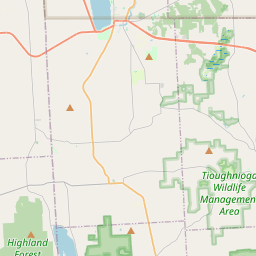Rounds Cemetery
Historical marker location:
3383 Lafayette Road, Lafayette, New York
( Marker is on Lafayette Road, on the left when traveling north.)
Marker installed: 2016







© OpenStreetMap contributors
Loading...
Searching for other points of interest within 3 miles of this location.New York State was home to several utopian communities in the 19th century, including the Oneida Community in central New York, which practiced communal living and free love, and the Shakers, who were known for their furniture and craftsmanship.
About Onondaga County
Onondaga County Timeline
Onondaga County, located in central New York, has a rich history dating back thousands of years. It was originally inhabited by the Onondaga nation, one of the six nations that formed the Iroquois Confederacy. The Onondaga people were skilled farmers and traders, and their influence extended throughout the region. In 1654, French Jesuit missionaries established a mission in the area, marking the first European presence.
The arrival of European settlers in the late 18th century brought significant changes to Onondaga County. In 1794, the area became part of the newly created Onondaga County, named after the Onondaga people. Syracuse, the county seat and current largest city, was founded in 1820 and quickly grew due to its advantageous location for transportation and industry. The construction of the Erie Canal, completed in 1825, further boosted the region's development by facilitating trade and connecting New York City with the Great Lakes.
By the mid-19th century, Onondaga County became an industrial hub, with a booming salt industry, manufacturing, and trade. The county's salt reserves were highly valuable, earning Syracuse the nickname "Salt City." The region also played a significant role in the abolitionist movement, with notable figures such as Harriet Tubman and Gerrit Smith actively involved in the Underground Railroad.
In the 20th century, Onondaga County continued to thrive, embracing innovation and industry. The area witnessed the growth of Syracuse University, established in 1870, as well as the development of various manufacturing sectors including automobiles, electronics, and defense. Today, Onondaga County remains a vibrant and diverse community, blending its rich history with modern advancements in education, technology, and cultural heritage.
The arrival of European settlers in the late 18th century brought significant changes to Onondaga County. In 1794, the area became part of the newly created Onondaga County, named after the Onondaga people. Syracuse, the county seat and current largest city, was founded in 1820 and quickly grew due to its advantageous location for transportation and industry. The construction of the Erie Canal, completed in 1825, further boosted the region's development by facilitating trade and connecting New York City with the Great Lakes.
By the mid-19th century, Onondaga County became an industrial hub, with a booming salt industry, manufacturing, and trade. The county's salt reserves were highly valuable, earning Syracuse the nickname "Salt City." The region also played a significant role in the abolitionist movement, with notable figures such as Harriet Tubman and Gerrit Smith actively involved in the Underground Railroad.
In the 20th century, Onondaga County continued to thrive, embracing innovation and industry. The area witnessed the growth of Syracuse University, established in 1870, as well as the development of various manufacturing sectors including automobiles, electronics, and defense. Today, Onondaga County remains a vibrant and diverse community, blending its rich history with modern advancements in education, technology, and cultural heritage.
Onondaga County Timeline
This timeline provides a condensed summary of the historical journey of Onondaga County, New York.
- 1600s - The area that would become Onondaga County is home to the Onondaga Nation, one of the six nations of the Haudenosaunee, or Iroquois Confederacy.
- 1779 - The Sullivan Expedition, led by General John Sullivan, devastates Onondaga settlements in retaliation for their support of the British during the American Revolution.
- 1784 - The Treaty of Fort Stanwix is signed, establishing boundaries and reaffirming the sovereignty of the Onondaga Nation.
- 1794 - Onondaga County is created as part of the newly formed state of New York.
- 1825 - The Erie Canal opens, connecting Onondaga County and Syracuse to the Great Lakes and transforming the region into a major transportation hub.
- 1834 - The city of Syracuse is officially incorporated.
- 1848 - The discovery of salt deposits near Syracuse leads to the development of a lucrative salt industry in the area.
- 1871 - Syracuse University is established.
- 1878 - The city of Syracuse becomes the county seat of Onondaga County.
- 1946 - The post-World War II era sees significant growth and development in Onondaga County, with expanding industries and infrastructure.
- 1971 - Destiny USA, one of the largest malls in the United States, opens in Syracuse.
- 2021 - Onondaga County continues to be a vibrant region with a diverse economy, including sectors such as healthcare, education, technology, and tourism.